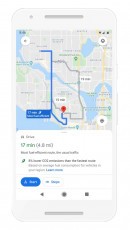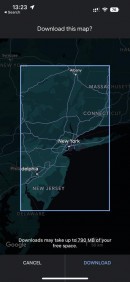Google Maps keeps getting better and better, and after several big announcements in the last few weeks, the search giant has come up with another update for users on iPhone and Android.
The parent company has been working around the clock on accessibility features in its products, and Google Maps is integral to this effort. As a result, Google Maps is getting accessibility features that many users will not only need but also enjoy using, making their lives easier when running the app for guidance.
Google is adding support for wheelchair-accessible walking routes, though the first thing you must keep in mind is that the feature is only available "wherever we have data available." The company doesn't elaborate on this front, but in plain English, it means the accessible walking routes are only available in select locations where the company can provide accurate information.
The feature is live on iPhone and Android and is already available today. However, considering the availability depends on Google's data, you might not see any change if you don't live in a region where the Google Maps update rolls out.
Google says that while the feature is primarily aimed at people who use wheelchairs, it can also come in handy when you travel with luggage or strollers. This is because the suggested walking routes do not include stairs, so it's easier to walk around.
Google Maps was already offering wheelchair-accessible transit for navigation, but with this update, the service also offers stair-free walking directions.
To enable the feature, you must activate the wheelchair-accessible option in transit preferences, as Google Maps will use this setting to also look for accessible walking routes. Additionally, you can expand the route settings when requesting walking directions and enable the wheelchair-accessible option.
Google Maps has also received other big improvements lately, including expanding eco-friendly routing to India and Indonesia. The fuel-efficient routes debuted two years ago to provide drivers with an alternative to the fastest routes, offering a way to reach their destination by reducing fuel consumption and cutting the vehicle's emissions. The feature is already available in Europe, the United States, and Canada, and Google says it has already reduced emissions by the equivalent of taking 500,000 vehicles off the road.
Google also announced immersive view for routes, using realistic simulations of the world to let drivers preview their routes before driving. The feature is only available in select regions, as it needs a tremendous amount of data, including combined aerial imagery and street-level photos. The immersive view takes into account essential data such as traffic conditions and the weather forecast, eventually turning its simulation into a realistic experience that users can browse in 3D from their devices. The feature will expand to more locations next year, but no specifics are available today.
Google is adding support for wheelchair-accessible walking routes, though the first thing you must keep in mind is that the feature is only available "wherever we have data available." The company doesn't elaborate on this front, but in plain English, it means the accessible walking routes are only available in select locations where the company can provide accurate information.
The feature is live on iPhone and Android and is already available today. However, considering the availability depends on Google's data, you might not see any change if you don't live in a region where the Google Maps update rolls out.
Google says that while the feature is primarily aimed at people who use wheelchairs, it can also come in handy when you travel with luggage or strollers. This is because the suggested walking routes do not include stairs, so it's easier to walk around.
Google Maps was already offering wheelchair-accessible transit for navigation, but with this update, the service also offers stair-free walking directions.
To enable the feature, you must activate the wheelchair-accessible option in transit preferences, as Google Maps will use this setting to also look for accessible walking routes. Additionally, you can expand the route settings when requesting walking directions and enable the wheelchair-accessible option.
Google Maps has also received other big improvements lately, including expanding eco-friendly routing to India and Indonesia. The fuel-efficient routes debuted two years ago to provide drivers with an alternative to the fastest routes, offering a way to reach their destination by reducing fuel consumption and cutting the vehicle's emissions. The feature is already available in Europe, the United States, and Canada, and Google says it has already reduced emissions by the equivalent of taking 500,000 vehicles off the road.
Google also announced immersive view for routes, using realistic simulations of the world to let drivers preview their routes before driving. The feature is only available in select regions, as it needs a tremendous amount of data, including combined aerial imagery and street-level photos. The immersive view takes into account essential data such as traffic conditions and the weather forecast, eventually turning its simulation into a realistic experience that users can browse in 3D from their devices. The feature will expand to more locations next year, but no specifics are available today.



















